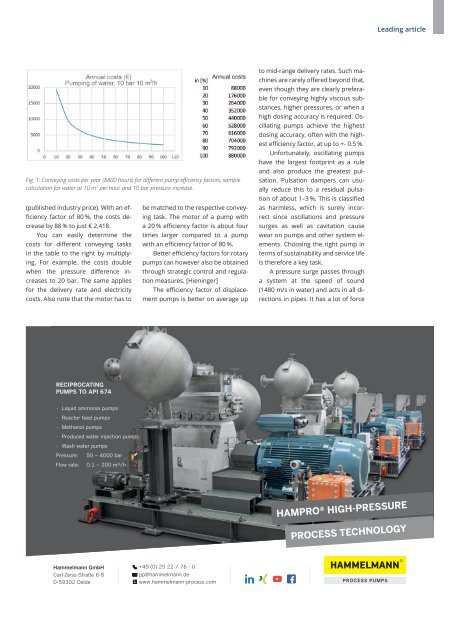PuK - Process Technology & Components 2024
A technical trade magazine with a history of more than 60 years.
A technical trade magazine with a history of more than 60 years.
Create successful ePaper yourself
Turn your PDF publications into a flip-book with our unique Google optimized e-Paper software.
Leading article<br />
Fig. 1: Conveying costs per year (8800 hours) for different pump efficiency factors, sample<br />
calculation for water at 10 m 3 per hour and 10 bar pressure increase.<br />
(published industry price). With an efficiency<br />
factor of 80 %, the costs decrease<br />
by 88 % to just € 2,418.<br />
You can easily determine the<br />
costs for different conveying tasks<br />
in the table to the right by multiplying.<br />
For example, the costs double<br />
when the pressure difference increases<br />
to 20 bar. The same applies<br />
for the delivery rate and electricity<br />
costs. Also note that the motor has to<br />
be matched to the respective conveying<br />
task. The motor of a pump with<br />
a 20 % efficiency factor is about four<br />
times larger compared to a pump<br />
with an efficiency factor of 80 %.<br />
Better efficiency factors for rotary<br />
pumps can however also be obtained<br />
through strategic control and regulation<br />
measures. [Hieninger]<br />
The efficiency factor of displacement<br />
pumps is better on average up<br />
to mid-range delivery rates. Such machines<br />
are rarely offered beyond that,<br />
even though they are clearly preferable<br />
for conveying highly viscous substances,<br />
higher pressures, or when a<br />
high dosing accuracy is required. Oscillating<br />
pumps achieve the highest<br />
dosing accuracy, often with the highest<br />
efficiency factor, at up to +- 0.5 %.<br />
Unfortunately, oscillating pumps<br />
have the largest footprint as a rule<br />
and also produce the greatest pulsation.<br />
Pulsation dampers can usually<br />
reduce this to a residual pulsation<br />
of about 1–3 %. This is classified<br />
as harmless, which is surely incorrect<br />
since oscillations and pressure<br />
surges as well as cavitation cause<br />
wear on pumps and other system elements.<br />
Choosing the right pump in<br />
terms of sustainability and service life<br />
is therefore a key task.<br />
A pressure surge passes through<br />
a system at the speed of sound<br />
(1480 m/s in water) and acts in all directions<br />
in pipes. It has a lot of force<br />
RECIPROCATING<br />
PUMPS TO API 674<br />
- Liquid ammonia pumps<br />
- Reactor feed pumps<br />
- Methanol pumps<br />
- Produced water injection pumps<br />
- Wash water pumps<br />
Pressure:<br />
Flow rate:<br />
50 – 4000 bar<br />
0,1 – 200 m³/h<br />
HAMPRO® HIGH-PRESSURE<br />
PROCESS TECHNOLOGY<br />
Hammelmann GmbH<br />
Carl-Zeiss-Straße 6-8<br />
D-59302 Oelde<br />
+49 (0) 25 22 / 76 - 0<br />
pp@hammelmann.de<br />
www.hammelmann-process.com

















